
PURPLE CONEFLOWER SEED HOW TO
Propagating Purple Coneflower – How to Start from SeedĮchinacea purpurea can be propagated by division or seed.


I would not discourage trying the different cultivars but if you are looking for the best chance to attract butterflies you may want to start with Echinacea purpurea. The native species appears to be the best, or at least among the best, attractor as well as being very robust. Some forum comments indicate that certain cultivars may not be as attractive to butterflies as is the species Echinacea purpurea. There are many cultivars of Echinacea (‘Magnus’, ‘Hot Summer’, ‘White Swan’, and many more). I haven’t come across a side-by-side comparison however, Echinacea purpurea is the one that is most commonly seen in lists of top butterfly plants. angustifolia (and several others) which may or may not be as good of nectar sources. There are other species of Echinacea such as E. Purple Coneflower does best in well drained soils and fertile loam but will tolerate some gravel or clay. Medium wetness or mesic conditions are best but it will also do well in areas with periods of wet soil as well as areas with drought conditions once established.
PURPLE CONEFLOWER SEED FULL
You can prevent self-sowing by dead-heading the blooms but if left to dry, the seeds are very attractive to birds, especially Finches.Įchinacea purpurea prefers full sun but will tolerate some shade especially in hot areas. This native will spread gently in a clump and will self-sow but is not considered invasive. It can be grown successfully in deep containers. As an herbaceous perennial, it will die back in the fall to return in the spring. Purple Coneflower is a perennial that grows about 4 ft high and flowers from mid-summer through fall. It is an extremely popular butterfly nectar plant from coast to coast. Purple Coneflower is native to Eastern and Central US from Canada down through the South but it is grown successfully throughout most of the US (hardy in USDA zones 3-9). But to really sweeten the deal, it is not only loved by butterflies but by gardeners everywhere because it is pretty, low-maintenance, hardy and gently spreads over time to create beautiful patches of color. Lists of top butterfly nectar plants almost always include Purple Coneflower.

Purple Coneflower Seeds (Echinacea purpurea) and Plants for Butterflies! Echinacea purpurea Native Plant Range


 0 kommentar(er)
0 kommentar(er)
